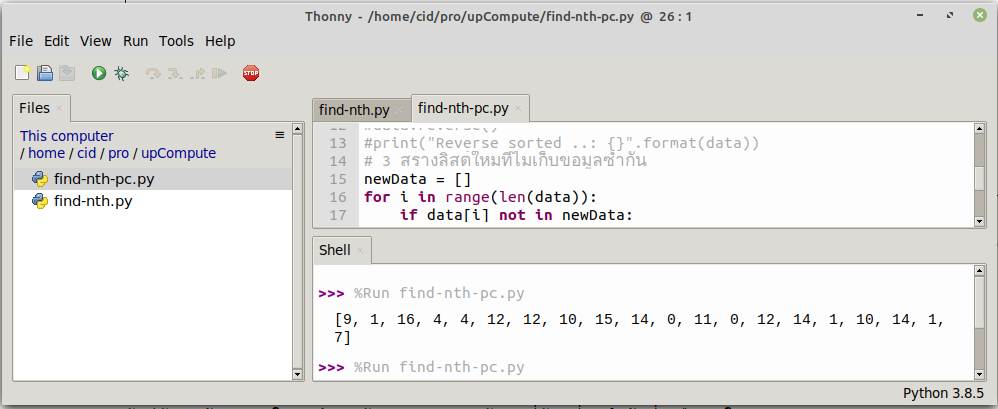[EN] WiFiClient
After mentioning the ESP8266WiFi class in the previous article. This time, let’s learn how to use the WiFiClient class to write programs on the client side that link to a service or server.

After mentioning the ESP8266WiFi class in the previous article. This time, let’s learn how to use the WiFiClient class to write programs on the client side that link to a service or server.

In this article, let’s understand and write a program to find the nth order from a list of data in Python, tested with Python and Micropython.

This article discusses the SPI bus functionality of the Arduino framework for use with the STM32F030F4P6, STM32F103C8, STM32F401, esp8266 and esp32. The operation of this bus requires at least 3 intercommunication cables: SCLK, MISO. and MOSI for transmitting the clock signal between the sender and the receiver. It serves to receive information from the sender. and used for sending information to the recipient.
From the use of 3 signal lines, it is found that data can be transmitted and received simultaneously. This is different from I2C bus communication that uses only one SDA cable to communicate. At the same communication speed, the SPI bus will receive and transmit data without waiting for an idle line, while I2C will have to wait for idle. With this in mind, SPI can send/receive data faster.
In addition, SPI uses a method to select the destination to communicate by instructing the endpoint to know by sending a signal to the SS pin of the terminal. Therefore, when connecting to multiple devices, SPI requires a larger number of pins to operate, while I2C uses device identification to communicate with each other by still using only one SDA cable, which saves more pins.

This article describes the methods of Wire.h, a class for communicating with devices over an I2C bus that uses two signal wires called SDA and SCL to transmit data between them. We have quite a number of articles about this type of communication and used as the main bus to develop devices by yourself and run through the bus, for example, articles on using esp8266 to connect to Arduino Uno or using esp8266 with stm32f030f4p6, etc.

This article is to learn how to use the Pin class which is a subclass in the machine class of Micropython for use with ESP8266 or ESP32 microcontrollers.

บทความกล่าวถึงการใช้ไลบรารี LittleFS และแนะนำไลบรารีที่ถูกพัฒนาเพื่อใช้กับไมโครคอนโทรเลอร์ esp32 ซึ่งมีส่วนเสริม (plugin) ของ Arduino IDE สำหรับอัพโหลดไฟล์ไปเก็บในรอมของไมโครคอนโทรลเลอร์ ทำให้สะดวกต่อการโหลดข้อมูลไปเก็บและเรียกใช้งาน ด้วยเหตุนี้ถ้าผู้เขียนโปรแกรมรู้สึกยุ่งยากกับการแปลงโค้ด HTML/CSS/JavaScript ให้เป็นสตริงด้วยตนเอง และเปลี่ยนมาเป็นอัพโหลดไฟล์ไปเก็บใน esp32 แล้วอ่านไฟล์เว็บมาใช้งานโดยตรงจะเป็นสิ่งที่จะต้องฝึกฝนใช้งานเจ้า LittleFS ไว้เป็นไลบรารีคู่ใจกันเลยทีเดียว

Random numbers in Python use the random class, but microcontrollers don’t support as much randomness as in computer systems, so Micropython supports different commands depending on the chip type. This article discusses how to use random with esp8266 and esp32 microcontrollers, which are instructed to just generate random numbers and configure the random seed as follows.

ในบทความก่อนหน้านี้ได้แนะนำการเขียนโปรแกรมเพื่อใช้โครงสร้างข้อมูลแบบคิวไปแล้ว ในบทความนี้จึงแนะนำการเขียนโปรแกรมจัดการโครงสร้างข้อมูล (Data Structure) อีกประเภทหนึ่งซึ่งมีวิธีการจัดเก็บและจัดการที่แตกต่างกันไปอันมีชื่อว่าต้นไม้แบบ BST หรือ Binary Search Tree ดังในภาพที่ 1 ซึ่งเป็นโครงสร้างที่สามารถนำไปประยุกต์เกี่ยวกับการเก็บข้อมูลที่มีคุณลักษณะที่ข้อมูลทางกิ่งด้านซ้ายมีค่าที่น้อยกว่าตัวเอง และกิ่งด้านขวามีค่ามากกว่าต้นเอง หรือทำตรงกันข้ามคือกิ่งซ้ายมีค่ามากกว่า และกิ่งด้านขวามีค่าน้อยกว่า ทำให้การค้นหาข้อมูลในกรณีที่ต้นไม้มีความสมดุลย์ทั้งทางซ้ายและทางขวาบนโครงสร้าง BST ประหยัดเวลาหรือจำนวนครั้งในการค้นหาลงรอบละครึ่งหนึ่งของข้อมูลที่มี เช่น มีข้อมูล 100 ชุด ในรอบแรกถ้าตัวเองยังไม่ใช่ข้อมูลที่กำลังค้นหา จะเหลือทางเลือกให้หาจากกิ่งทางซ้ายหรือขวา ซึ่งการเลือกทำให้ข้อมูลของอีกฝั่งนั้นไม่ถูกพิจารณา หรือตัดทิ้งไปครึ่งหนึ่งโดยประมาณ แต่ถ้าเป็นกรณีที่ Binary Search Tree นั้นขาดความสมดุลย์จะส่งผลให้การค้นหามีความเร็วไม่แตกต่างกับการค้นหาแบบลำดับ (Sequential Search) เท่าใดนัก
ในบทความนี้ใช้ภาษาไพธอนที่ทำงานได้ทั้งบนตัวแปลภาษา Python 3 หรือ MicroPython เพื่อจัดเก็บข้อมูล การเพิ่มข้อมูล การค้นหาข้อมูล เพื่อเป็นตัวอย่างของการนำไปพัฒนาต่อไป

This article takes a detailed look at the Micropython machine.RTC class. The main function of this class is designed to be an RTC (Real-Time Clock) inside the microcontroller for storing date and time. It is more convenient when used with ESP8266 or ESP32 chip because NTP can be accessed to read the date and time from the internet and then store the value into the RTC to enable the accuracy and do not require frequent internet access to read the values again. This saves the use of external RTC circuits as well.

This article is a tutorial on how to use esp and esp32 classes, which are dedicated classes for esp8266 and esp32 microcontrollers to access specific features and the internal abilities of the two chips.
